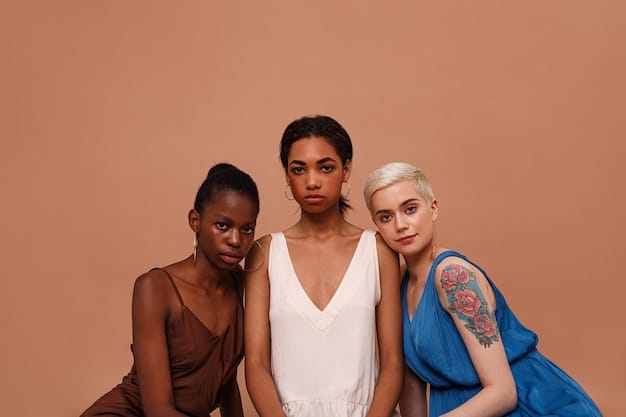Color Theory for Fashion: Flattering Colors for Your Skin Tone

Color theory for fashion provides a framework for selecting the most flattering colors that complement your skin tone, enhancing your natural features and creating harmonious outfits.
Unlock the transformative power of color in fashion. Understanding and applying color theory for fashion allows you to curate a wardrobe that not only reflects your personal style but also enhances your natural beauty by harmonizing with your unique skin tone.
Understanding the Basics of Color Theory
Color theory is the foundation of visual harmony. It encompasses the color wheel, color harmonies, and how colors interact with each other. Learning these fundamentals is crucial for making informed decisions about your wardrobe.
Understanding the color wheel is the first step in mastering color theory. The color wheel consists of primary, secondary, and tertiary colors, each with its own unique properties and relationships.
The Color Wheel and Its Components
The color wheel is a visual representation of colors arranged according to their chromatic relationship. It helps us understand how different colors relate to each other and how they can be combined to create harmonious or contrasting effects.
- Primary Colors: Red, yellow, and blue are the primary colors. They cannot be created by mixing other colors and serve as the foundation for all other colors.
- Secondary Colors: Green, orange, and purple are created by mixing two primary colors. For instance, mixing red and yellow yields orange.
- Tertiary Colors: These are created by mixing a primary color with a neighboring secondary color. Examples include red-orange, yellow-green, and blue-violet.
Understanding these components is essential for creating balanced and visually appealing outfits. Knowing how colors interact can help you choose combinations that enhance your natural features.

In summary, the color wheel provides a roadmap for understanding color relationships. It’s a foundational tool for anyone looking to improve their fashion choices and create visually pleasing outfits.
Identifying Your Skin Tone
Identifying your skin tone is the cornerstone of selecting flattering colors. Skin tone is categorized as warm, cool, or neutral, and understanding yours will guide you towards colors that enhance your complexion. This is about identifying the undertones, not the surface color.
The first step in this process is accurately determining your skin tone. There are several methods for this, each designed to help you uncover your underlying complexion.
Methods for Determining Your Skin Tone
Determining your skin tone can be done through various simple tests. These methods will help you accurately identify whether you have warm, cool, or neutral undertones.
- The Vein Test: Look at the veins on your wrist. If they appear blue or purple, you likely have cool undertones. If they appear green, you probably have warm undertones. If you can’t tell or see both colors, you may have neutral undertones.
- The Jewelry Test: Consider how your skin looks with gold versus silver jewelry. If gold looks better, you likely have warm undertones. If silver looks better, you probably have cool undertones. If both look equally good, you are likely neutral.
- The White Fabric Test: Hold a piece of stark white fabric up to your face in natural light. Notice how your skin looks against the white. If your skin looks pink, rosy, or blueish, you likely have cool undertones. If your skin looks yellow, golden, or olive, you probably have warm undertones.
These methods provide a starting point for identifying your skin tone. Experiment and observe how different colors interact with your complexion to fine-tune your understanding.
Ultimately, identifying your skin tone is a process of self-discovery. Use these methods as a guide, but trust your intuition and observation to select colors that make you feel confident and look your best.
Colors for Warm Skin Tones
Warm skin tones benefit from colors that enhance their natural golden or olive undertones. Earthy tones, rich reds, and warm greens can create a harmonious and radiant look. The key is to choose colors that bring out the warmth in your complexion.
When selecting colors for warm skin tones, consider the specific shades within the warm color palette. Not all warm colors are created equal, and some will complement your complexion better than others.
Best Colors for Warm Undertones
The best colors for warm skin tones are those that mirror and enhance the skin’s natural warmth. These colors tend to be rich, deep, and evocative of nature.
- Earthy Tones: Colors like olive green, mustard yellow, and terracotta brown are excellent choices. They complement the natural warmth of the skin without overpowering it.
- Warm Reds: Shades like brick red, rusty orange, and deep crimson can add a vibrant touch. These reds bring out the warmth in the skin, creating a healthy and radiant glow.
- Golds and Bronzes: Metallic shades such as gold, bronze, and copper enhance the skin’s natural luminosity. These colors are perfect for accent pieces or evening wear.

By focusing on these colors, individuals with warm skin tones can create a wardrobe that accentuates their natural beauty. These colors work in harmony with their complexion, resulting in a polished and vibrant appearance.
In conclusion, selecting colors for warm skin tones involves embracing the richness and depth of the warm color palette. Earthy tones, warm reds, and metallic accents work together to create a radiant and harmonious look.
Colors for Cool Skin Tones
Cool skin tones shine in colors that complement their rosy or bluish undertones. Jewel tones, cool blues, and soft pastels can enhance their complexion, creating a balanced and sophisticated appearance.The idea is to find colors that don’t clash.
For cool skin tones, the right color choices can brighten the complexion and highlight natural features. Understanding which colors work best involves identifying shades that harmonize with the cool undertones.
Ideal Colors for Cool Undertones
The best colors for cool skin tones are those that reflect the coolness of the skin. These colors often have a blue or purple base and evoke a sense of sophistication and elegance.
- Jewel Tones: Colors like sapphire blue, emerald green, and amethyst purple are fantastic choices. They add depth and vibrancy while complementing the cool undertones.
- Cool Blues: Shades like sky blue, ice blue, and navy blue provide a calming and harmonious effect. These blues enhance the skin’s natural clarity.
- Soft Pastels: Colors like lavender, baby pink, and mint green can create a delicate and flattering look. These pastels bring out the skin’s natural rosiness.
By incorporating these colors, people with cool skin tones can curate a wardrobe that enhances their natural beauty. These colors work in tandem with their complexion, resulting in a polished and refined appearance.
In summary, colors for cool skin tones revolve around selecting shades that mirror the skin’s inherent coolness. Jewel tones, cool blues, and soft pastels work together to create a balanced and elegant aesthetic.
Colors for Neutral Skin Tones
Neutral skin tones have the advantage of versatility, as they can often wear a wide range of colors. However, certain shades are particularly flattering, bringing balance and harmony to the complexion. The key is to experiment and find what works best for your unique coloring.
For those with neutral skin tones, the range of suitable colors is broad, but strategic choices can make all the difference. It involves identifying colors that neither overwhelm nor wash out the complexion.
Flattering Colors for Neutral Undertones
The most flattering colors for neutral skin tones are those that strike a balance between warm and cool shades. These colors tend to be muted and versatile, enhancing the skin’s natural equilibrium.
- Muted Greens: Colors like sage green, olive green, and muted teal are excellent choices. They add a touch of color without overpowering the skin’s natural tone.
- Soft Neutrals: Shades like taupe, mushroom gray, and off-white create a subtle and sophisticated look. These neutrals enhance the skin’s brightness.
- Dusty Pinks: Colors like rose, blush, and dusty rose can add a gentle warmth. These pinks bring out the skin’s natural radiance.
By focusing on these colors, individuals with neutral skin tones can build a wardrobe that showcases their natural beauty. These colors work in harmony with their complexion, resulting in a balanced and polished appearance.
In conclusion, colors for neutral skin tones involve selecting balanced shades that complement the skin’s natural equilibrium. Muted greens, soft neutrals, and dusty pinks work together to create a harmonious and sophisticated aesthetic.
Beyond the Basics: Complexion and Hair Color
While skin tone is a primary factor, hair color and overall complexion also play a role in selecting the most flattering colors. Understanding how these elements interact can elevate your wardrobe choices even further.This combination works the best.
Beyond skin tone, integrating hair color and complexion considerations can fine-tune your color selection process. This approach involves understanding how all your features work together to create a cohesive and visually appealing look.
Integrating Hair Color and Complexion
When selecting colors, it’s important to consider how your hair color and complexion work together. The right color choices can enhance both, creating a harmonious and striking appearance.
For example, someone with fair skin and dark hair might look stunning in bold, jewel-toned colors. These colors provide a vivid contrast that highlights both the skin and hair.
Conversely, someone with warm skin and blonde hair might prefer softer, earthier tones. These colors complement the skin’s warmth and the hair’s lightness, creating a cohesive and natural look.
Ultimately, integrating hair color and complexion considerations involves a holistic approach to color selection. By understanding how all your features interact, you can create a wardrobe that enhances your overall appearance.
In summary, selecting the most flattering colors involves considering not only your skin tone but also your hair color and overall complexion. By taking a holistic approach, you can create a wardrobe that enhances your natural beauty.
| Key Aspect | Brief Description |
|---|---|
| 🎨 Color Theory | Understanding primary, secondary, and tertiary colors. |
| ☀️ Skin Tone | Identifying warm, cool, or neutral undertones. |
| 👗 Warm Tones | Earthy tones and rustic reds for golden undertones. |
| 💎 Cool Tones | Jewel tones and soft pastels for rosy undertones. |
FAQ
▼
Use the vein test, jewelry test, or white fabric test to identify your skin’s undertones. Blue/purple veins suggest cool, green veins suggest warm, and both or unclear veins suggest neutral undertones.
▼
Warm skin tones are flattered by earthy tones like olive green and mustard yellow, warm reds like brick and rust, and metallic shades like gold and bronze.
▼
Cool skin tones look best in jewel tones like sapphire and emerald, cool blues like sky and ice blue, and soft pastels like lavender and baby pink.
▼
Neutral skin tones are versatile but look particularly good in muted greens like sage and teal, soft neutrals like taupe and mushroom, and dusty pinks like rose and blush.
▼
Consider your hair color when choosing outfits. Bold colors suit dark hair and fair skin, while softer tones complement blonde hair and warm skin, creating a balanced, cohesive look.
Conclusion
Mastering color theory for fashion empowers you to make informed wardrobe choices that enhance your natural beauty. By understanding your skin tone and incorporating complementary colors, you can create harmonious outfits that boost your confidence and style.





